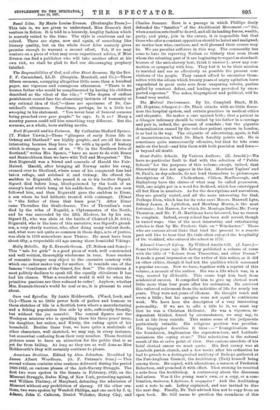Earl ROgnvald and his Forbears. By Catharine Stafford Spence. (T.
Fisher Unwin.)—These "glimpses of early Norse life in Orkney and Shetland" are highly graphic, and are all the more interesting because they have to do with a by-path of history which is strange to most of us. "We in the Northern Isles of Scotland," writes Mrs. Spence, "have no more to do with Bruce and Bannockburn than we have with Tell and Morgarten." The first Rognvald was a friend and comrade of Harold the Fair- Haired. Harold, after bringing all Norway under his sway, crossed over to Shetland, where some of his conquered foes had taken refuge, and subdued it and Orkney. He offered the earldom to Regnvald, who passed it on to his brother Sigurd. Sigurd died before long, blood-poisoned by the tooth of an enemy's head which hung at his saddle-bow. Sigurd's son soon followed him, and then ROgnvald gave the earldom to Einar, a son whom he had hitherto treated with contempt. (Einar is "the father of them that burn peat.") After Einar came Thornfinn the Skull-cleaver. Two of Thornfinn's sons died by the wiles of Ragnild, a Clytemnestra of the North, and he was succeeded by the fifth Hlodver, he by his son, Sigurd II., who was slain at the battle of Clontarf (A.D. 1014). Rognvald, who is the hero of this narrative, was Sigurd's grand- son, a very sturdy warrior, who, after doing many valiant deeds, and, what were not quite so common in those days, acts of justice, was slain in 1158 somewhere near Thurso. He must have been about fifty, a respectable old age among these homicidal Vikings.


















































 Previous page
Previous page